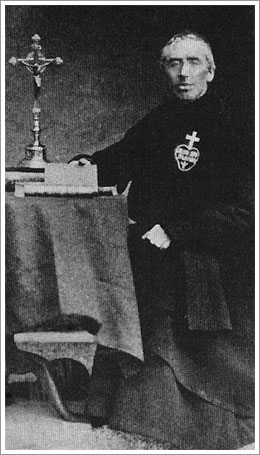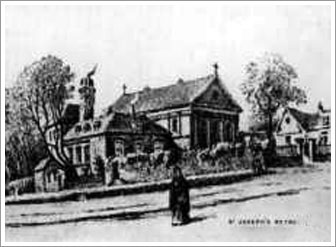Charles had set out from Mount Argus anticipating a long and lonely journey to St Saviour’s. Things turned out differently, however, as one of the novices noted in the Novitiate Chronicles:
Wednesday, 4 July 1866. Today the Rev. Fr Charles arrived from Dublin and also Br Michael, a lay Brother, came with him by mistake. According to his own story he was intent on arranging the berth of Fr Charles when the boat put out to sea and so he though he would come all the way and make a good job of a bad one.
 Br Michael was rewarded for his mistake with a few days’ holiday in Broadway, staying until 9 July, when the farewell was repeated in reverse, with Charles accompanying him as far as Evesham. right: Brother Michael Behan, C.P.
Br Michael was rewarded for his mistake with a few days’ holiday in Broadway, staying until 9 July, when the farewell was repeated in reverse, with Charles accompanying him as far as Evesham. right: Brother Michael Behan, C.P.
Although Charles had never been stationed in Broadway before, there were some familiar faces among the community. The Novice Master was Fr Raymond Disano, who had worked with him in St Wilfrid’s Parish, Cotton and, subsequently, at Mount Argus. Fr Raymond know that he had been sent to St Saviour’s to rest and so he took him under his wing; by bringing him for walks in the country and inviting him to the novices’ recreation he helped Charles to relax after the strain of the recent events in Dublin and, slowly, to rebuild his strength.
After a while Charles was able to take part in some of the works of the community. His voice was put to good use in the liturgy: we find him singing the Gospel at the High Mass on Sundays and the lessons at Matins on feast days. There was a small parish attached to the monastery and occasionally he would help the Parish Priest, but always under the watchful eye of Fr Raymond.
Charles stayed at Broadway about a year and a half; it was for him like a second novitiate experience. His room was near the chapel and he too advantage of the peace and quiet of the house, devoting more time to prayer than had been possible in Dublin. On 2 November 1867 the Provincial, seeing that his state of health was greatly improved and that he would now be ready for something more demanding, transferred Charles to St Anne’s Retreat, Sutton. The novices were sorry to see him go, but glad to have had the opportunity of getting to know him, as we read in the Novitiate Chronicles:
His departure was like his whole life, quiet, and hidden for the sake of Him, for whom alone he lives. He did not, however, go without taking an affectionate farewell of all. He visited the novices in the recreation room, and after taking his leave of each one separately, and giving him his blessing, he left, expressing a wish ‘to see them all again before he’d die’. May we all follow the example he left us!
‘This evening arrived here from Broadway Fr Charles who is appointed to remain here as a member of this community’, noted the Rector of St Anne’s Retreat in his diary; with these words Fr Salvian Nardocci, now in Sutton, began once more to record for us Charles’ activities. Fr Salvian had handed over the care of the Novitiate to Fr Raymond the previous year, moving to Sutton as Rector and Parish Priest. His task was not an easy one as the parish was very large but, he tells us,
I was fortunate in having a very good community of religious, always ready for any work according to their condition: the priests in preaching, hearing confessions, attending sick-calls, going for supplies, or preaching Charity Sermons, and every other sacred duty of ministry, and the lay-brothers in performing their special duties cheerfully, and carefully, so that I had no occasion of complaining of any one. I do not mean that we were all saints, but I say only that I had good subjects who did their duty to my satisfaction and, I hope, to their merit.
Charles was a valuable addition to the community, and Fr Salvian put him to work immediately, visiting the sick and burying the dead, instructing in the school and preaching in the church. In his sermons, which were very simple, it was his sincerity which touched the hearts of those who heard him, as we learn from Fr Cyprian Meagher:
When I was a student in Lancashire I was told by my brethren that when he was in that place some time before, he was preaching on one occasion on the Eternal Truths and was so overcome by the realisation of what he was saying that he could not continue and had to be brought down weeping.
At Cotton Hall Fr Salvian had given Charles the ‘whole care’ of the novices. Now at Sutton the same thing was happening, as he began to put Charles’ generosity to good use. According to Fr Salvian,
Night and day, he was called to the sick: he administered the Holy Sacraments, remained until a late hour in the confessional, catechised, preached: in a word, the burden of the work fell upon the shoulders of Fr Charles.
 While at Sutton, however, Charles’ ministry was not confined to his own parish. We read of him being sent to help in other places, such as Warrington, Widnes and even, from time to time, Mount Argus. Nor were his contacts with Ireland confined to these visits. He received frequent letters asking for his prayers and occasionally a visitor would arrive from Ireland to ask for his blessing; Fr Salvian notes that on 1 April 1868 that ‘a poor sickly young man came here from Dublin to be blessed by Fr Charles. He left Sutton this afternoon.’
While at Sutton, however, Charles’ ministry was not confined to his own parish. We read of him being sent to help in other places, such as Warrington, Widnes and even, from time to time, Mount Argus. Nor were his contacts with Ireland confined to these visits. He received frequent letters asking for his prayers and occasionally a visitor would arrive from Ireland to ask for his blessing; Fr Salvian notes that on 1 April 1868 that ‘a poor sickly young man came here from Dublin to be blessed by Fr Charles. He left Sutton this afternoon.’
On 25 September 1872, after almost five years at St Anne’s Retreat, Charles was moved to London, to St Joseph’s Retreat, Highgate. This time he stayed fifteen months in London but, as before, there is no information to be found about what he did there; the house records tell us only the date of his arrival at Highgate and the date on which he left. above, right: a 19th century postcard image of St Joseph's, Highgate, London
top of page

© Paul Francis Spencer, C.P. 2007 - 2020 - all rights reserved
This biography, paper-published in 1988 at the time of Father Charles’ beatification, was how I became acquainted with the life of Father Charles. Although you will find the entire text at this site, I encourage you to look for the new paper edition of the book, which will be available in bookshops in mid-2007.

